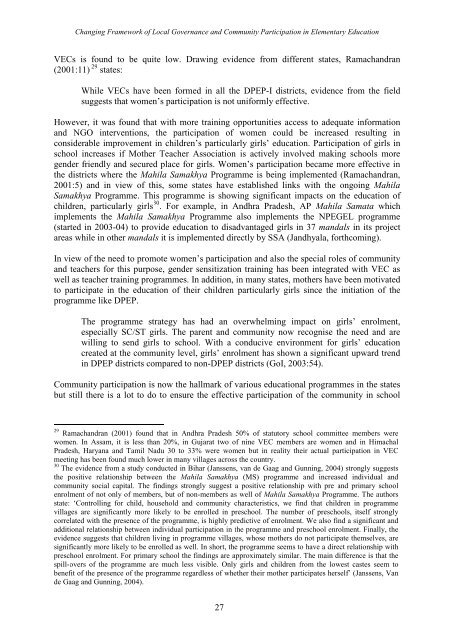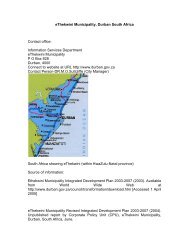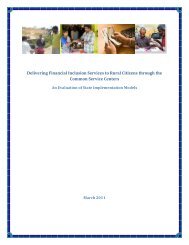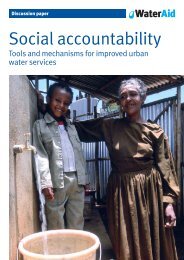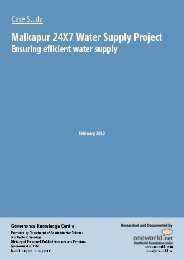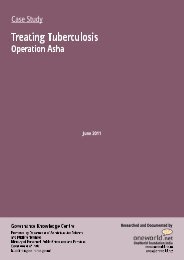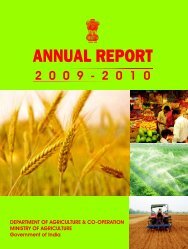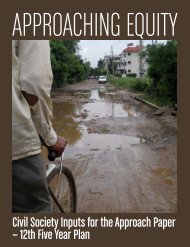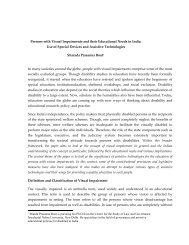Changing Framework of Local Governance and - Create
Changing Framework of Local Governance and - Create
Changing Framework of Local Governance and - Create
You also want an ePaper? Increase the reach of your titles
YUMPU automatically turns print PDFs into web optimized ePapers that Google loves.
<strong>Changing</strong> <strong>Framework</strong> <strong>of</strong> <strong>Local</strong> <strong>Governance</strong> <strong>and</strong> Community Participation in Elementary EducationVECs is found to be quite low. Drawing evidence from different states, Ramach<strong>and</strong>ran(2001:11) 29 states:While VECs have been formed in all the DPEP-I districts, evidence from the fieldsuggests that women’s participation is not uniformly effective.However, it was found that with more training opportunities access to adequate information<strong>and</strong> NGO interventions, the participation <strong>of</strong> women could be increased resulting inconsiderable improvement in children’s particularly girls’ education. Participation <strong>of</strong> girls inschool increases if Mother Teacher Association is actively involved making schools moregender friendly <strong>and</strong> secured place for girls. Women’s participation became more effective inthe districts where the Mahila Samakhya Programme is being implemented (Ramach<strong>and</strong>ran,2001:5) <strong>and</strong> in view <strong>of</strong> this, some states have established links with the ongoing MahilaSamakhya Programme. This programme is showing significant impacts on the education <strong>of</strong>children, particularly girls 30 . For example, in Andhra Pradesh, AP Mahila Samata whichimplements the Mahila Samakhya Programme also implements the NPEGEL programme(started in 2003-04) to provide education to disadvantaged girls in 37 m<strong>and</strong>als in its projectareas while in other m<strong>and</strong>als it is implemented directly by SSA (J<strong>and</strong>hyala, forthcoming).In view <strong>of</strong> the need to promote women’s participation <strong>and</strong> also the special roles <strong>of</strong> community<strong>and</strong> teachers for this purpose, gender sensitization training has been integrated with VEC aswell as teacher training programmes. In addition, in many states, mothers have been motivatedto participate in the education <strong>of</strong> their children particularly girls since the initiation <strong>of</strong> theprogramme like DPEP.The programme strategy has had an overwhelming impact on girls’ enrolment,especially SC/ST girls. The parent <strong>and</strong> community now recognise the need <strong>and</strong> arewilling to send girls to school. With a conducive environment for girls’ educationcreated at the community level, girls’ enrolment has shown a significant upward trendin DPEP districts compared to non-DPEP districts (GoI, 2003:54).Community participation is now the hallmark <strong>of</strong> various educational programmes in the statesbut still there is a lot to do to ensure the effective participation <strong>of</strong> the community in school29 Ramach<strong>and</strong>ran (2001) found that in Andhra Pradesh 50% <strong>of</strong> statutory school committee members werewomen. In Assam, it is less than 20%, in Gujarat two <strong>of</strong> nine VEC members are women <strong>and</strong> in HimachalPradesh, Haryana <strong>and</strong> Tamil Nadu 30 to 33% were women but in reality their actual participation in VECmeeting has been found much lower in many villages across the country.30 The evidence from a study conducted in Bihar (Janssens, van de Gaag <strong>and</strong> Gunning, 2004) strongly suggeststhe positive relationship between the Mahila Samakhya (MS) programme <strong>and</strong> increased individual <strong>and</strong>community social capital. The findings strongly suggest a positive relationship with pre <strong>and</strong> primary schoolenrolment <strong>of</strong> not only <strong>of</strong> members, but <strong>of</strong> non-members as well <strong>of</strong> Mahila Samakhya Programme. The authorsstate: ‘Controlling for child, household <strong>and</strong> community characteristics, we find that children in programmevillages are significantly more likely to be enrolled in preschool. The number <strong>of</strong> preschools, itself stronglycorrelated with the presence <strong>of</strong> the programme, is highly predictive <strong>of</strong> enrolment. We also find a significant <strong>and</strong>additional relationship between individual participation in the programme <strong>and</strong> preschool enrolment. Finally, theevidence suggests that children living in programme villages, whose mothers do not participate themselves, aresignificantly more likely to be enrolled as well. In short, the programme seems to have a direct relationship withpreschool enrolment. For primary school the findings are approximately similar. The main difference is that thespill-overs <strong>of</strong> the programme are much less visible. Only girls <strong>and</strong> children from the lowest castes seem tobenefit <strong>of</strong> the presence <strong>of</strong> the programme regardless <strong>of</strong> whether their mother participates herself’ (Janssens, V<strong>and</strong>e Gaag <strong>and</strong> Gunning, 2004).27


